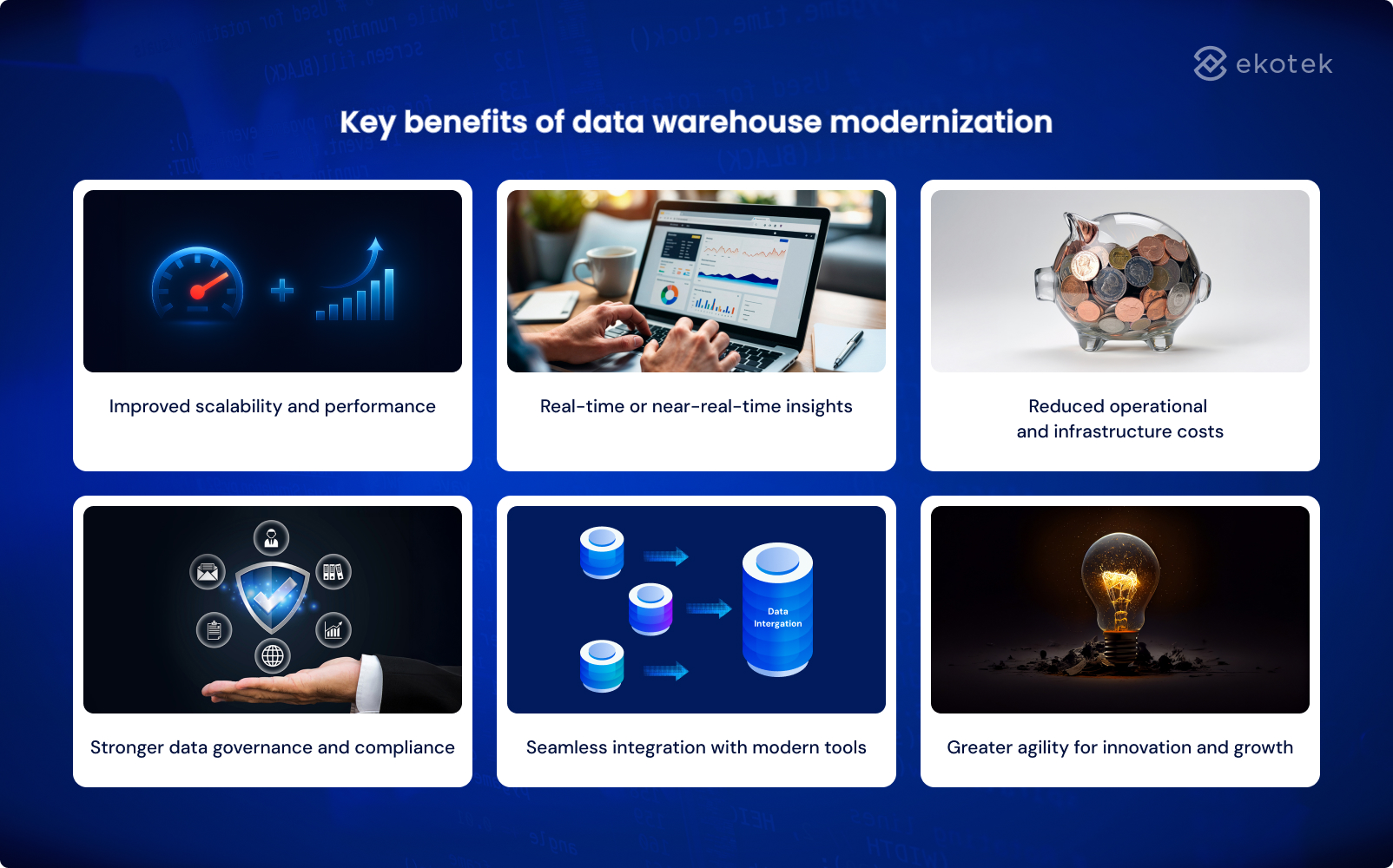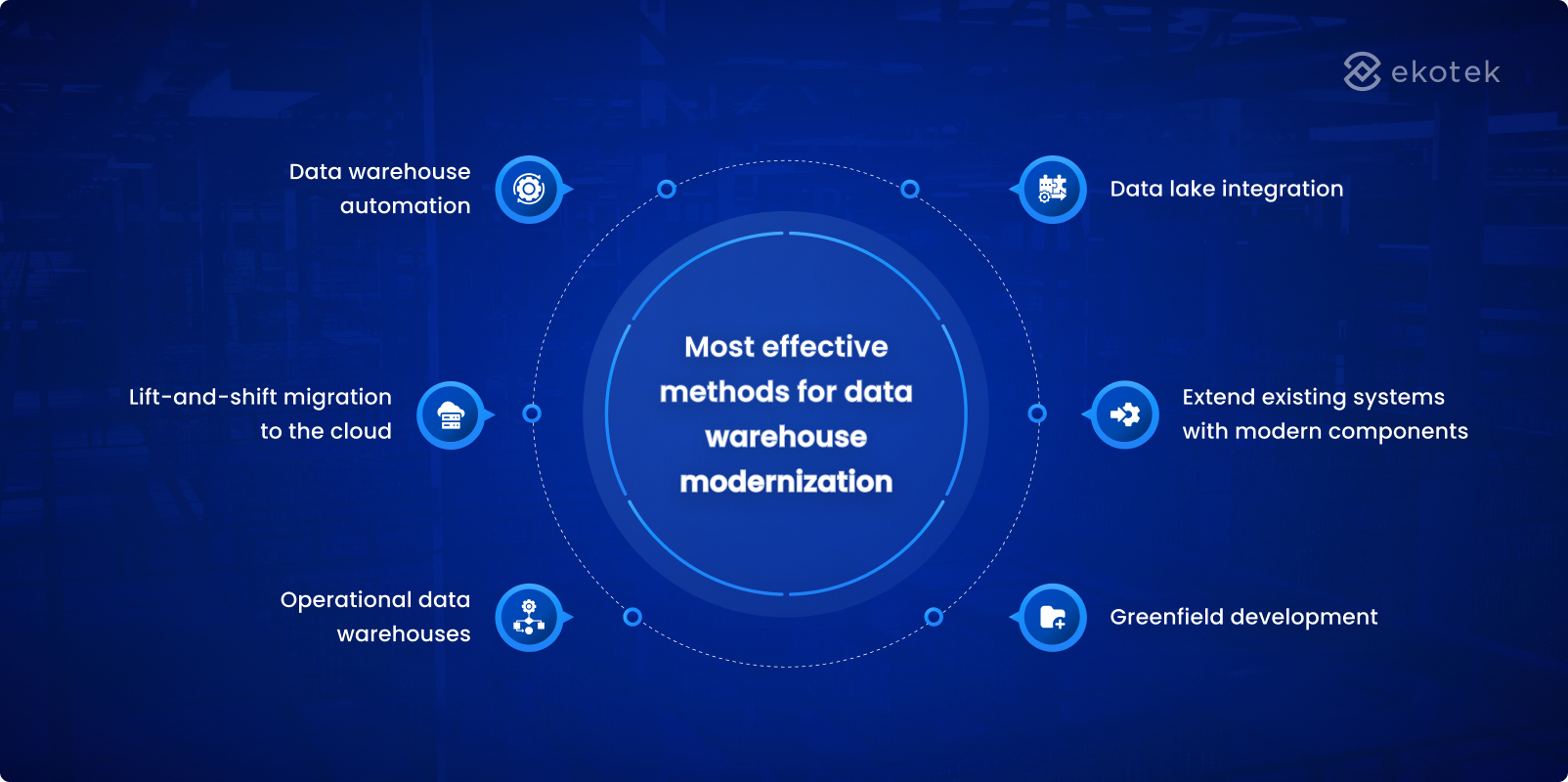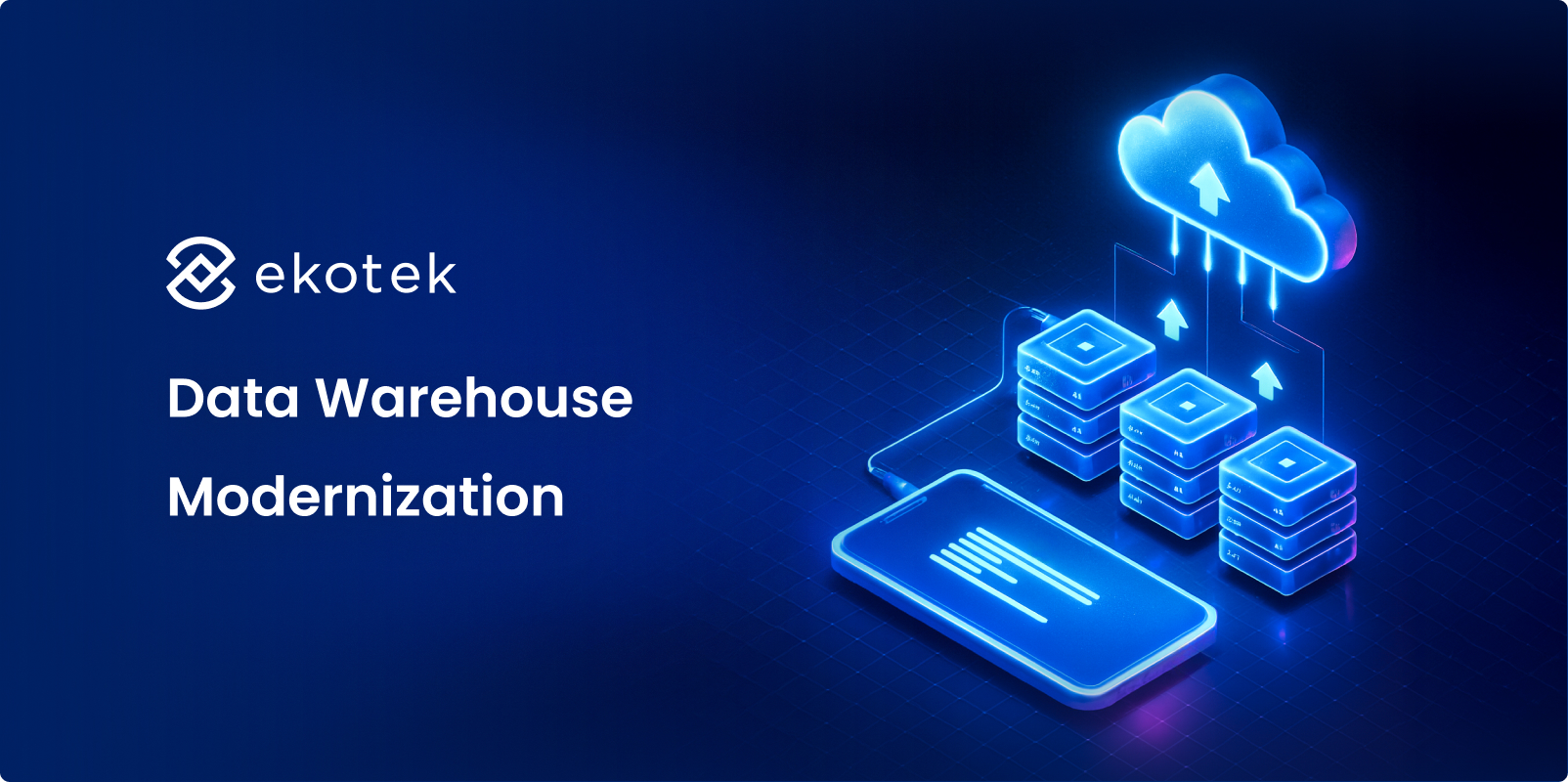
- 1
- 2
- 3
- 4
- 5
- 6
- 7
- 8
- 9
Introduction
Data is growing at an exponential rate by 2025, it’s estimated that the world will generate over 180 zettabytes of data annually. For many enterprises, legacy data warehouse systems are no longer equipped to handle this scale and complexity. Traditional architectures often struggle with performance bottlenecks, rigid data models, and high operational costs.
In this fast-changing digital landscape, data warehouse modernization has become a critical step for organizations aiming to stay competitive. Modernizing your data infrastructure is a strategic move that can unlock faster insights, reduce costs, and fuel innovation.
This blog will explore the key business benefits that data warehouse modernization offers, the most effective methods used today and a practical step-by-step roadmap.
What is data warehouse modernization?
Data warehouse modernization is the process of transforming traditional, on-premise data warehouse systems into modern, cloud-native platforms that can meet today’s data and analytics requirements.
Legacy data warehouses were designed decades ago, primarily to store structured data and support batch reporting. While they served well in the past, they often struggle with growing data volumes, real-time demands, and integration with modern tools and technologies.
Modernization involves moving to more agile, scalable architectures, typically in the cloud and redesigning data processes to support real-time analytics, automation, and interoperability with tools like artificial intelligence and machine learning.
This shift is about enabling the business to respond faster to change, make data-driven decisions, and unlock new opportunities from data that older systems simply cannot support efficiently.
Modernization vs. legacy data warehouse
| Aspect | Legacy data warehouse | Modern data warehouse |
|---|---|---|
| Infrastructure | On-premise hardware | Cloud-native architecture |
| Data processing | Batch processing | Real-time or near-real-time analytics |
| Cost structure | High maintenance and hardware costs | Optimized for cost-efficiency (pay-as-you-go) |
| Scalability | Limited and manual scaling | Elastic, auto-scalable compute & storage |
| Integration | Siloed systems and data | Integrated with data lakes, tools, APIs |
| Flexibility | Rigid architecture | Agile, adaptable to business needs |
| Analytics capability | Historical reporting only | Advanced analytics with AI/ML integration |
| User access | IT-controlled, limited access | Self-service analytics for business users |
This comparison highlights how modern data warehouses overcome the key limitations of legacy systems. While traditional warehouses were built for stability and control, modern platforms prioritize speed, scalability, and flexibility, critical factors for today’s fast-moving, data-driven businesses.
Key benefits of data warehouse modernization
Improved scalability and performance
Legacy systems often bottleneck as data volumes grow. Modern cloud-native platforms offer elastic scalability, automatically adjusting compute and storage resources based on demand. This ensures consistent performance even during peak loads, without the need for manual intervention or overprovisioning.
👉 Discover how to modernize core banking strategically
Real-time or near-real-time insights
In fast-paced markets, waiting hours or even minutes for reports is no longer acceptable. Modern architectures enable real-time data ingestion and analytics, giving teams up-to-the-minute visibility into operations, customer behavior, and market trends. This supports proactive decision-making, not just reactive responses.
Reduced operational and infrastructure costs
Cloud platforms eliminate capital expenditures on hardware and reduce ongoing costs for maintenance, upgrades, and system administration. Pay-as-you-go models and automated resource management help optimize spend, especially for growing businesses or those with fluctuating workloads.
Stronger data governance and compliance
Modern data warehouses come with built-in tools for access control, auditing, encryption, and policy management, making it easier to enforce governance and meet evolving regulatory requirements (GDPR, HIPAA). This reduces risk and strengthens data trust across the organization.
Seamless integration with modern tools
Unlike siloed legacy systems, modern warehouses integrate natively with analytics tools (Power BI, Looker), AI/ML platforms, and APIs. This opens up broader use cases from predictive modeling to automated workflows, without requiring complex custom integrations.
👉 Learn how Ekotek enabled one client to modernize operations and increase production efficiency
Greater agility for innovation and growth
An agile, cloud-based data environment shortens the time it takes to test new ideas, onboard new data sources, or launch new digital services. IT can focus more on innovation and less on infrastructure, while business units gain the flexibility to adapt quickly to market changes.
Most effective methods for data warehouse modernization
Data warehouse automation
This method leverages automation tools for tasks like schema conversion, code generation, testing, and deployment. It significantly reduces manual effort, speeds up delivery, and minimizes human error. This is especially effective for organizations aiming to accelerate modernization with limited internal resources or tight timelines.
Lift-and-shift migration to the cloud
This approach involves migrating existing on-premise data warehouses to cloud platforms like Snowflake, Amazon Redshift, Google BigQuery, or Azure Synapse, without major changes to data models or workflows. It works well for companies looking to quickly gain cloud scalability and flexibility while maintaining their existing architecture.
👉 Get the strategic guide that leading enterprises are using to modernize successfully.
Operational data warehouses (Hybrid workloads)
Modern platforms allow blending transactional and analytical data workloads in one environment. This enables real-time dashboards, live reporting, and better responsiveness across business units. It is ideal for businesses that need real-time operational insights and faster feedback loops in daily decision-making.
Data lake integration
Integrating your data warehouse with a data lake creates a unified architecture capable of handling structured and unstructured data. This supports advanced analytics, AI/ML, and broader data exploration. It’s a strong choice for enterprises with diverse data types and growing needs for flexibility and analytical depth.
Extend existing systems with modern components
Instead of full replacement, organizations can incrementally modernize by layering modern components, such as cloud storage, real-time ingestion, or new analytics tools, on top of existing systems. This is well-suited for businesses that want to modernize gradually with minimal disruption to ongoing operations.
Greenfield development
This approach involves building a brand-new, cloud-native data warehouse from scratch. It provides maximum flexibility, clean architecture, and the ability to design for current and future needs. It’s most appropriate for organizations undergoing large-scale digital transformation or those burdened by outdated, inflexible legacy systems.
Step-by-step guide to modernizing your data warehouse
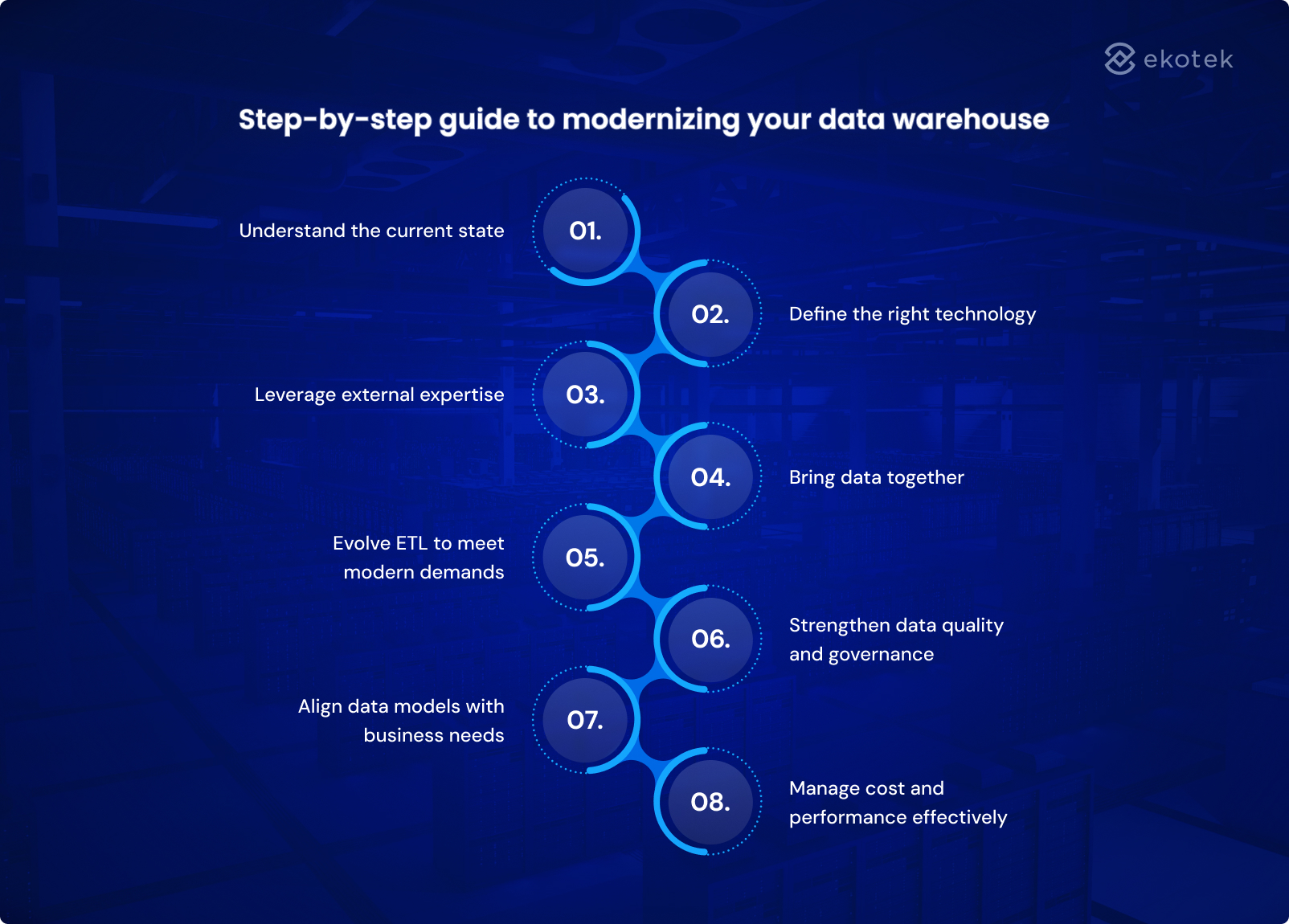 Understand the current state
Understand the current state
A clear view of the existing data landscape provides the foundation for change. This involves examining legacy systems, data flows, and existing performance issues. It’s also important to identify any compliance risks or data quality concerns that may affect the transition. Organizations often use this step to prioritize which areas of the warehouse need modernization first.
Define the right technology
Modernizing your data warehouse often starts with choosing the right technology approach. Depending on your goals and resources, this may involve
- Rehosting (lifting existing systems to the cloud)
- Replatforming (moving to a managed cloud service with minor optimizations)
- Refactoring (redesigning the architecture to fully leverage cloud-native capabilities).
Each path offers different trade-offs in terms of cost, complexity, and long-term scalability, so it’s important to align your choice with both current needs and future growth.
Leverage external expertise
Many organizations find value in outsourcing to specialized service providers or consulting firms with deep experience in cloud data architecture, migration planning, and governance. This approach not only helps accelerate implementation timelines but also reduces the burden on internal teams, who may lack the time or expertise to manage complex transformation projects. Strategic outsourcing can also bring fresh perspectives, access to best practices, and greater flexibility as business needs evolve.
👉 Before you sign your next outsourcing contract, read this complete vendor evaluation guide
Bring data together
A common challenge in traditional environments is fragmented data, stored across multiple departments and systems. Modernization offers an opportunity to unify this information. When data is integrated into a centralized platform, it becomes more consistent, reliable, and usable for analysis, which, in turn, enhances decision-making across the business.
Evolve ETL to meet modern demands
As data volumes grow and business needs become more real-time, traditional ETL processes may no longer suffice. Many companies shift toward scalable, cloud-based ETL or ELT pipelines that support both batch and streaming data. This evolution allows for faster data delivery and more agile analytics.
Strengthen data quality and governance
For data to drive meaningful insights, it must be trusted. Establishing clear processes for data validation, profiling, and cleansing helps maintain integrity throughout the pipeline. At the same time, introducing governance practices, such as access controls, lineage tracking, and role-based permissions, ensures data is secure and compliant with internal and external standards.
Align data models with business needs
Well-designed data models serve as the bridge between raw data and business insights. In a modernized environment, modeling efforts typically reflect how different teams consume and interact with data. By aligning models with actual business logic and KPIs, organizations make it easier for teams to access the insights they need without deep technical expertise.
Manage cost and performance effectively
Modern data warehouse platforms offer flexibility and scalability, but they also introduce new variables around cost management. Visibility into usage patterns, storage consumption, and query behavior can help organizations stay in control. Forecasting tools and proactive optimization strategies contribute to both performance and budget stability over time.
Sustaining success after data warehouse modernization
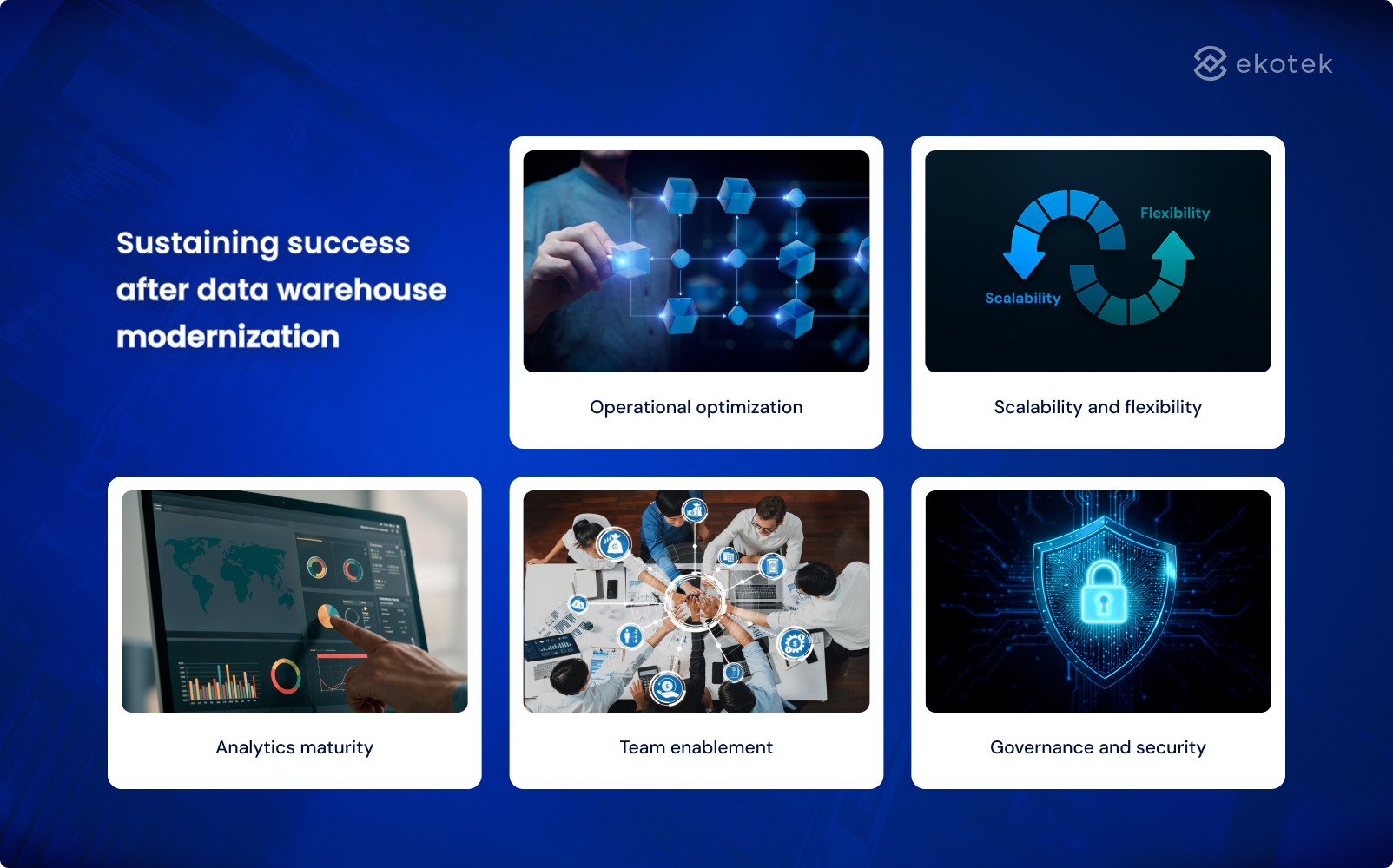 Operational optimization
Operational optimization
After migration, regular performance tuning and cost optimization become essential. Cloud platforms provide flexibility, but without careful monitoring, compute and storage expenses can grow rapidly. Leveraging built-in analytics, automation, and usage policies helps ensure efficiency without compromising performance.
Scalability and flexibility
As your business grows, so will the volume, variety, and velocity of data. A modernized data warehouse should be able to scale seamlessly to support new use cases, departments, or external data sources, without requiring re-architecture.
Analytics maturity
A modern platform sets the stage for advanced use cases like predictive analytics, real-time dashboards, and AI/ML integration. Enabling these capabilities requires not just technical readiness but also alignment with business goals and data literacy across teams.
👉 From strategy to execution, here’s everything you need to know about AI integration
Team enablement
Technology can only deliver value when people are empowered to use it. Ongoing training and upskilling help business analysts, data engineers, and decision-makers make the most of new tools and workflows. This also builds internal confidence and reduces dependency on external support.
Governance and security
Robust governance ensures data remains accurate, compliant, and secure as it flows through various systems and users. Policies around access control, data lineage, audit trails, and regulatory compliance must evolve alongside the architecture.
Ekotek’s proven success in data warehouse modernization
Modernize core banking platforms
A leading Japanese bank partnered with Ekotek to overhaul its legacy infrastructure. Our team delivered a modern data architecture that enabled real-time analytics, streamlined regulatory reporting, and improved customer insight, all while minimizing operational risk.
We accelerated delivery through agile IT staffing and re-engineered both customer-facing and internal systems to meet enterprise-grade performance demands.
Legacy migration
Ekotek successfully migrated a mission-critical ACI system to the cloud for a global logistics company.
The result:
- Scalable data warehousing
- Reduced latency
- Faster time-to-market for new services, fully aligned with compliance requirements.
We ensured full data integrity during migration, revamped the UX/UI, and delivered a stable, AWS-hosted system ready for future expansion.
👉 Discover how Ekotek delivered a high-stakes migration
Conclusion
Data warehouse modernization is a necessity for businesses seeking to stay agile, scalable, and competitive in today’s data-driven economy. From improving real-time analytics and reducing operational costs to enabling AI/ML integration and enhancing data governance, the benefits are clear. By following a structured modernization approach, you can lay the foundation for long-term success and innovation.
Ekotek brings deep expertise in data architecture, cloud migration, and large-scale modernization initiatives. Whether you’re upgrading legacy systems, building real-time analytics capabilities, or enabling AI-ready infrastructure, we’re here to guide every step of your transformation. With proven success across industries, our team delivers results that are fast, scalable, and secure.
Contact Ekotek today to start building a modern data foundation that supports growth, agility, and innovation.
- 1
- 2
- 3
- 4
- 5
- 6
- 7
- 8
- 9
